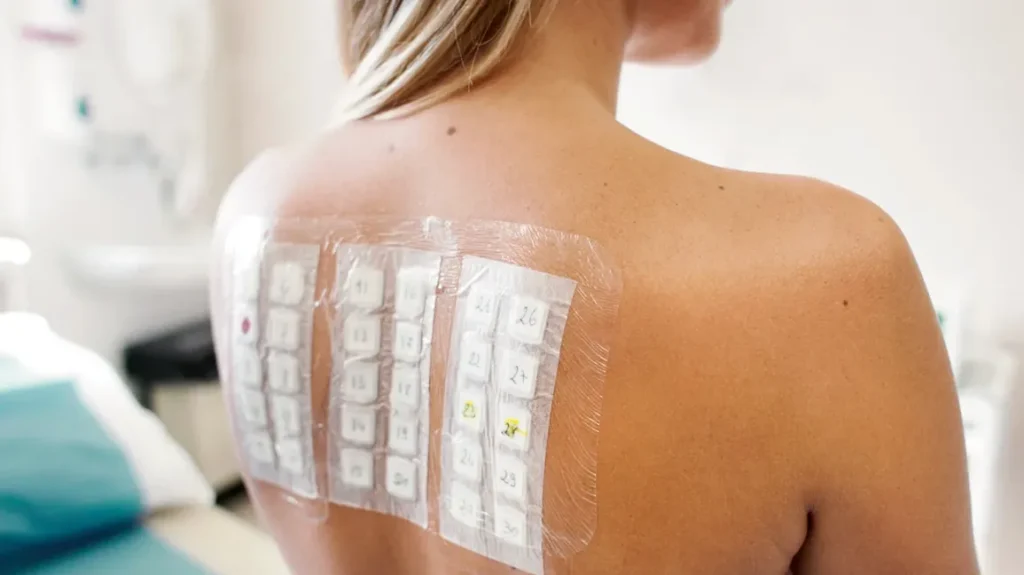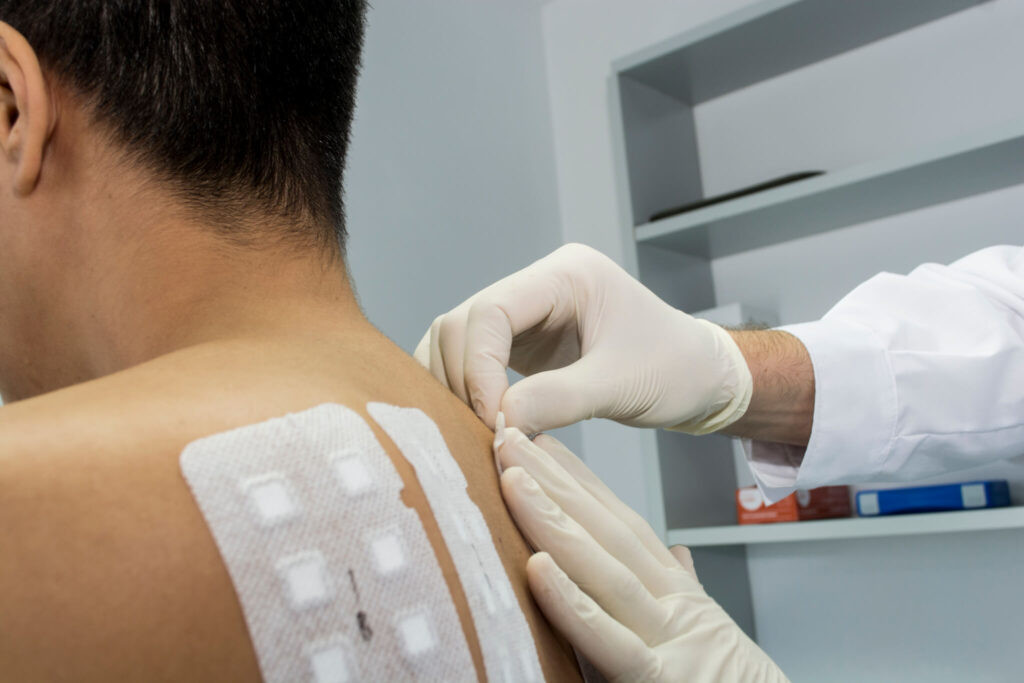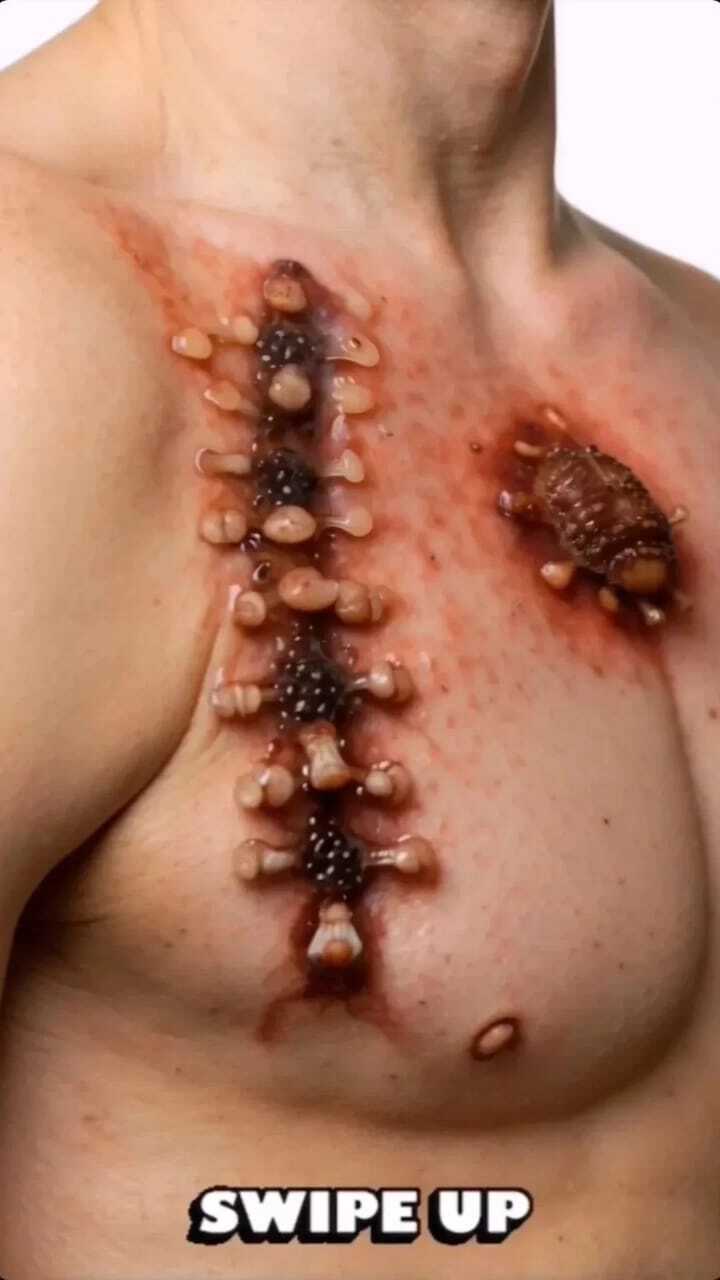Allergy patch testing is an easy and helpful way to find out what might be causing skin allergies. If you have rashes, itching, or irritation that you can’t explain, this test can help identify specific triggers. During the test, small patches with possible allergens are placed on your skin, and your doctor will check for reactions over time. The results help you understand what to avoid, so you can prevent future allergic reactions. Allergy patch testing is a great way to discover what’s affecting your skin and take steps to treat and protect it. Whether it’s products, plants, or other common allergens, this test can help you keep your skin healthy and irritation-free.
Patch Testing
Patch testing is a procedure used by doctors to find out what’s causing a skin rash known as contact allergy (also called contact dermatitis or allergic contact dermatitis). During the test, small panels with different allergens are placed on your back. These panels are left on your skin for 48 hours. If you’re allergic to any of the substances, you’ll see a reaction when the panels are removed. Patch testing is a safe and trusted way to identify what’s triggering your skin irritation.
Is Patch Testing the Same as Allergy Testing?
Patch testing is just one type of allergy test. There are also blood tests and another skin test called a “prick test” or “scratch test.” These tests help find out if you have an immediate allergic reaction to things like peanuts, pollen, mold, pet dander, or dust mites. In contrast, patch testing is used to identify delayed allergic reactions, like those seen in contact dermatitis. This condition causes a rash after touching something you’ve become sensitive to. It could be something you were only exposed to once, like a henna tattoo or medicine, or a product you use often, like perfume or jewelry. The rash may appear days, weeks, or even months after you first come into contact with the substance.
What Allergens Can Patch Detect?
Patch testing helps identify what’s causing allergic reactions, like as metals, fragrances, or certain plants and foods. Common allergens include nickel (found in jewelry), latex, and preservatives. Even gold can cause reactions in some people. There are standard sets of allergens for testing, as well as special sets for different areas of the body or specific jobs. Your doctor will pick the right allergens for you based on your needs. Whether you’re a digital Pakistani or anyone else dealing with allergies, patch testing is an important step in finding the right solution.
How Long Does Patch Testing Take?
Patch testing usually requires two visits to your dermatologist. During the first visit, a nurse or clinician will apply the patch test panels to your back, which takes less than an hour. Two days later, you’ll return for the second visit, where the doctor will remove the patches and check for any reactions to the test substances. Sometimes, a third visit is needed to ensure an accurate result and to discuss your treatment. Most reactions happen within 5 days, but some can take up to 10 days. If needed, your doctor may schedule another visit between days 7 and 10 to check the results.

What Does a Positive Patch Result Look Like?
A positive patch test result can show up as a small rash, swelling, red bumps, blisters, or hives. The stronger the reaction, the more sensitive you are to the allergen. Sometimes, an irritant reaction can happen, which might look like an allergy but isn’t. An experienced dermatologist will make sure your results are read correctly.
What if my Patch Result is Negative?
A negative patch test result means you are not allergic to the substances tested. If that happens, your doctor might test you with other substances to find the cause. This process will continue until the allergen causing your contact dermatitis is found. Thankfully, 35 of the most common allergens cause about 66-75% of all allergic contact dermatitis cases.
How Accurate is Allergy Patch Testing?
Patch testing isn’t always 100% accurate. It might show a “false positive,” where it says you have an allergy when you don’t, or a “false negative,” where it misses an allergy you actually have. Still, patch testing is the best way to find contact allergies. Seeing a dermatologist trained in patch testing gives you the best chance for an accurate result.
Is Patch Testing Uncomfortable?
Patch test panels are now more comfortable than before. You might feel them on your skin, but they are small and flexible, making them easier to wear.
It’s normal to feel some itching or slight burning at the test sites while wearing the patch panels, as your skin is exposed to different chemicals. However, if the sensation becomes strong, contact your doctor right away. Try not to scratch the area, as it can make the irritation worse and affect the test results.
Side effects are rare. Some people may have skin reactions to the adhesive or the aluminum in the patch test, but this doesn’t happen often. Also, patch testing shouldn’t make you feel unwell.
How Much Does Patch Cost?
Patch testing usually costs around $1000, including 2 or 3 office visits and $9 for each allergen tested. However, many patients pay less. Experts agree that for people with ongoing eczema or rashes, patch testing can save time and money in the long run. Since contact dermatitis often lasts a lifetime, patch testing costs less than many doctor visits, prescriptions, and time off work. Without the right diagnosis, patients might keep suffering or paying for treatments they don’t need.

Are There Alternatives to Patch Testing?
Patch is the most reliable way to find out what’s causing contact allergies because it can quickly narrow down the allergens responsible for your dermatitis. Another test often used is the Open Application Test (ROAT). Unlike patch testing, which checks 35 to 85 allergens at once, ROAT tests just one allergen at a time. It’s recommended when you suspect a specific product is causing a rash, like cosmetics, face creams, or fragrances. In this test, the substance is applied to a small area of skin over several days to see if it causes a reaction. ROAT helps test everyday products that may contain ingredients not covered in patch tests. Whether you’re a “digital Pakistani” looking for allergy solutions or just seeking better skin care, understanding these tests can help you manage your skin health more effectively.
There’s no other way to find a contact allergen except through a slow process of trial and error. This method can take a long time and may not give accurate results.
What Do You Wear During a Patch?
During patch testing, the panels are usually placed on your back, so you’ll need to remove your shirt or blouse and wear a short medical gown that leaves your back open. You don’t need to take off lower-body clothing like pants or skirts. Women can keep their bra on, but it should be unfastened during the test. You can fasten it again and wear it for the next 48 hours while the test is in place.
Will Patch Testing Interfere With My Daily Activities?
Patch testing doesn’t interfere much with your daily activities, but avoid:
- Sweating or exercising
- Getting the test area wet (like showering or swimming)
- Moving too much so the patches don’t come off
- Sun exposure
Final Word on Patch Testing
There’s no “cure” for contact allergies, but with your dermatologist’s help, you can manage it and live a good life. The first step is getting an accurate diagnosis through patch testing. Once your doctor knows what’s causing the reaction, they can recommend the right treatment and care plan.
Whether you’re a “digital Pakistani” or anyone seeking help, understanding the cause of your allergy is key to feeling better.
